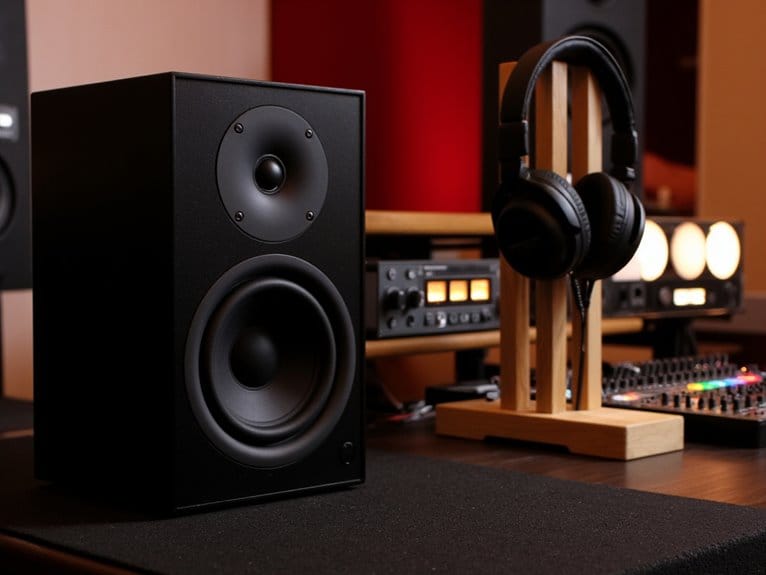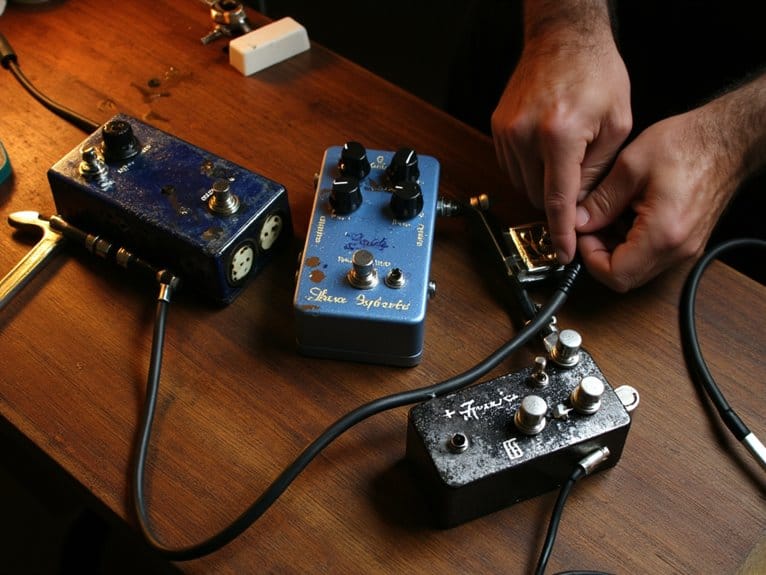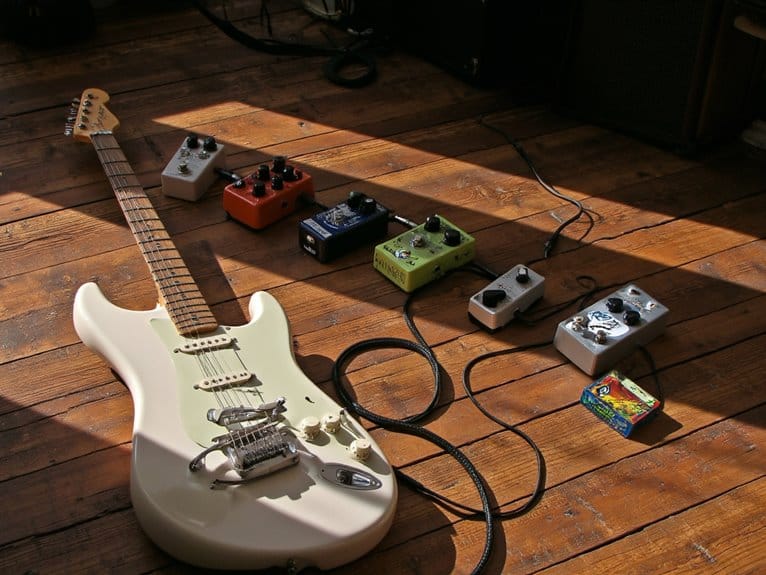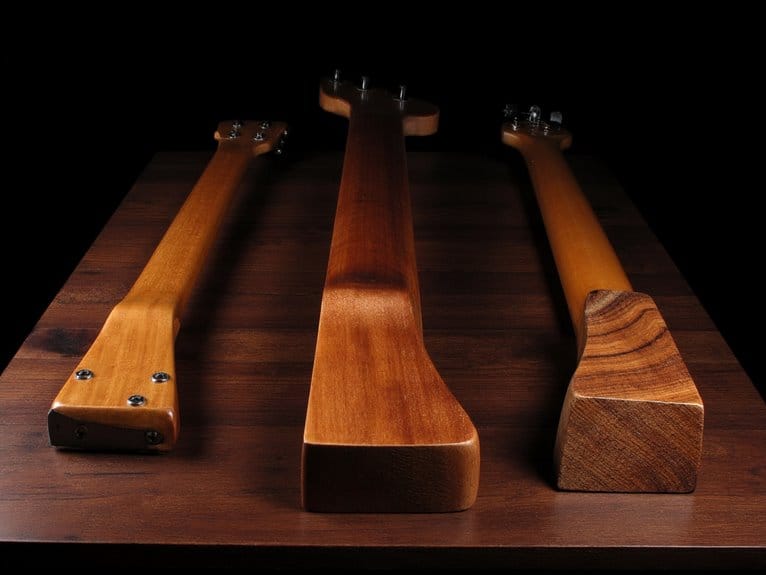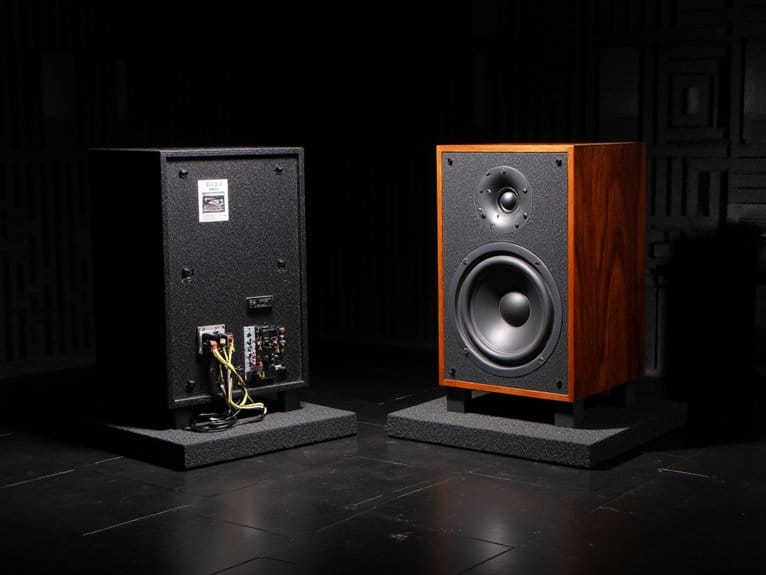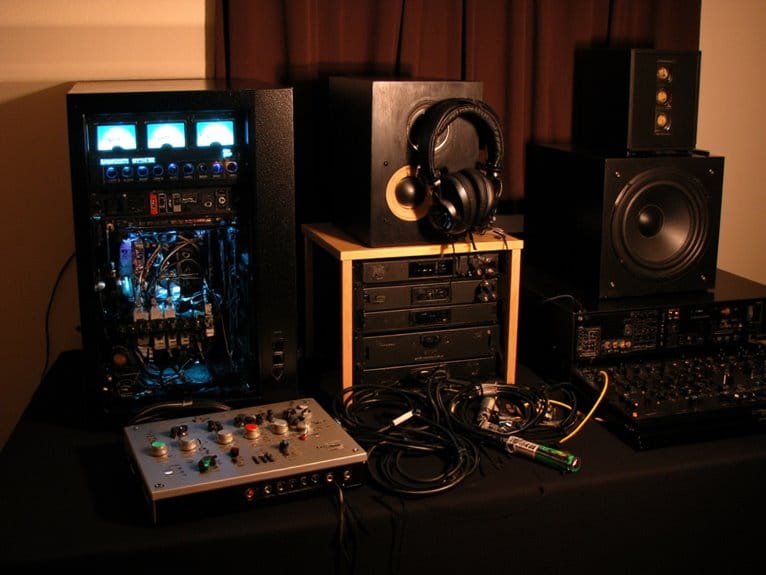Studio Monitor Vs Headphone Guide: When to Use Each
You’ll want studio monitors for accurate spatial imaging and natural sound reproduction when your room has proper acoustic treatment, while headphones excel for detailed editing in untreated spaces and mobile work. Monitors create realistic stereo fields through physical speaker interactions, but headphones deliver isolated channels directly to your ears with exaggerated separation. Choose monitors for client sessions and overall mix balance, headphones for precise EQ work and sound isolation, though combining both tools optimizes your workflow potential.
We are supported by our audience. When you purchase through links on our site, we may earn an affiliate commission, at no extra cost for you. Learn more.
Notable Insights
- Use studio monitors for mixing spatial placement, stereo imaging, and overall mix balance when working in acoustically treated rooms.
- Choose headphones for detailed audio editing, sound isolation in noisy environments, and mobile production work without acoustic treatment.
- Monitors provide natural soundstage and room interactions, while headphones offer precise scrutiny of subtle sonic elements and frequencies.
- Alternate between both tools every 20-30 minutes to prevent ear fatigue and ensure accurate mix translation across playback systems.
- Prioritize monitors for client collaboration and professional mixing, headphones for recording sessions to prevent sound leakage into microphones.
Understanding the Core Differences Between Studio Monitors and Headphones
When I first started mixing audio professionally, I quickly discovered that choosing between studio monitors and headphones isn’t just about personal preference-it’s about understanding how each technology fundamentally interacts with sound reproduction and your listening environment.
Studio monitors physically emit sound waves that bounce off walls, creating natural spatial perception, while headphones deliver audio directly to your ears, bypassing room acoustics entirely. This fundamental difference shapes everything from stereo imaging to frequency response accuracy.
Your audio preferences will naturally evolve as you experience how monitors provide external sound localization compared to headphones’ internal presentation. The acoustic variety in your workspace becomes essential with monitors, requiring proper treatment, whereas headphones eliminate environmental variables completely, making them ideal for untreated spaces or mobile production work.
For professional audio monitoring, headphones offer zero latency performance that’s essential for real-time applications, while monitors may introduce slight delays depending on your audio interface and room correction systems. Studio monitors enable natural crosstalk between left and right channels, which enhances spatial perception and creates more realistic three-dimensional sound placement compared to the isolated channel presentation of headphones.
How Sound Reproduction Differs Between Monitors and Headphones
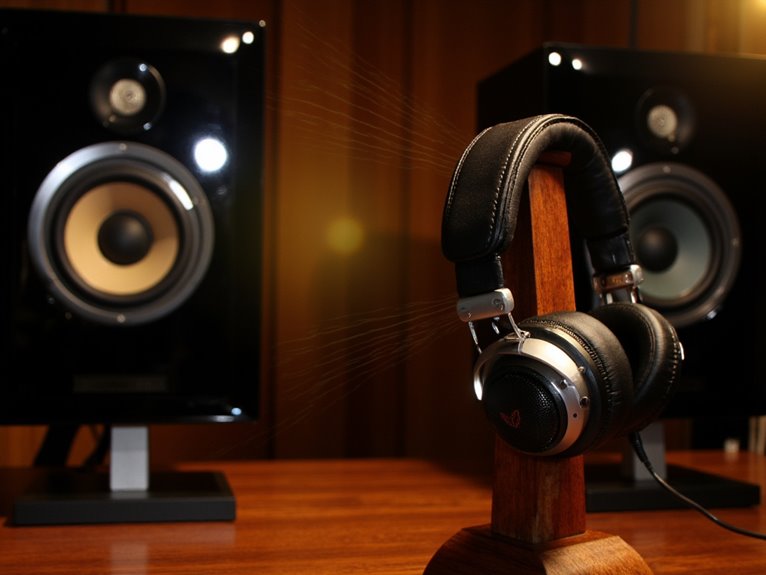
Although both studio monitors and headphones serve the same fundamental purpose of converting electrical signals into audible sound, the way they actually deliver that audio to your ears creates dramatically different listening experiences that’ll directly impact your mixing decisions.
While studio monitors and headphones both convert electrical signals to sound, their delivery methods create vastly different listening experiences that shape mixing choices.
When you’re listening through monitors, sound wave interactions with your room’s surfaces create natural reflections and phase shifts that mimic real-world environments.
In contrast, headphones bypass these acoustic interactions entirely by delivering isolated channels directly to each ear.
This fundamental difference means headphone frequency response often exaggerates stereo separation and creates an artificial “inside your head” soundstage, whereas monitors produce realistic spatial depth through air movement and environmental cues that help your brain process volume and directional information more naturally.
The quality of your monitoring setup ultimately depends on the analog-to-digital conversion process of your audio interface, which determines how accurately your original recordings translate through either playback method. Professional audio interfaces typically achieve dynamic ranges of 120dB or better to ensure transparent signal reproduction through both monitors and headphones.
Frequency Response Characteristics and Their Impact on Mixing
Beyond the spatial differences we’ve covered, the way monitors and headphones handle frequency response creates some of the most significant variations you’ll encounter in your mixing workflow.
Honestly, these differences can make or break your final mix if you don’t understand how each tool colors what you’re hearing.
Here’s what you need to know about frequency response impact:
- Headphone variability: Your closed-back headphones can exhibit wildly different frequency responses depending on fit and seal, affecting dynamic range perception.
- Monitor consistency: Studio monitors maintain more predictable frequency curves, though room acoustics still influence what you hear.
- Harmonic distortion patterns: Each tool type introduces distinct harmonic distortion characteristics that color your mix decisions.
- Target curve differences: Monitors typically aim for flatter response while headphones often follow curves like Harman for perceived accuracy.
Professional audio interfaces with 120dB dynamic range provide the necessary headroom to accurately reproduce these frequency response characteristics across both monitoring systems.
However, even with quality monitors, you’ll need adequate preamp gain from your audio interface to ensure clean signal capture, especially when recording dynamic microphones that require significant amplification.
Spatial Audio and Soundstage Capabilities
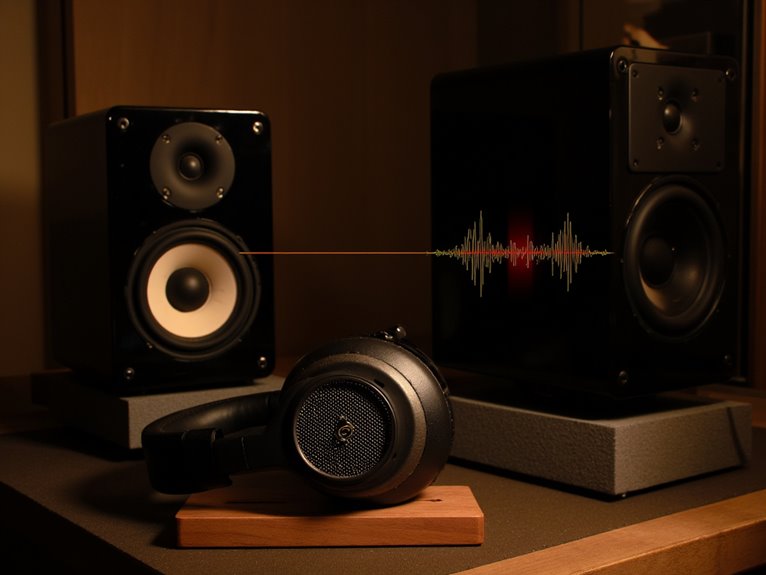
When you’re evaluating studio monitors against headphones, you’ll quickly discover that spatial audio capabilities represent one of the most significant differences between these two monitoring approaches.
I’ve found that monitors create a natural stereo field that allows your brain to process sound localization, phantom center imaging, and three-dimensional positioning exactly as it would in real-world listening environments.
Headphones, while offering their own advantages, simply can’t replicate this authentic spatial experience because they isolate each ear’s audio channel, preventing the natural cross-feed and acoustic interactions that your brain relies on for accurate soundstage perception.
Natural Stereo Field Perception
How does your brain naturally process the spatial information that determines whether a guitar sounds like it’s coming from your left or right, and why does this matter so much for audio production?
With studio monitors, you’re experiencing how sound actually behaves in a natural soundscape, where acoustic interaction between speakers and your room creates the timing differences your brain uses to build that three-dimensional audio map.
Studio monitors excel at delivering authentic stereo field perception through several key mechanisms:
- Phase relationships between left and right channels remain intact as sound waves travel through air.
- Room reflections provide additional spatial cues that headphones simply can’t replicate.
- Physical speaker separation creates genuine phantom imaging between drivers.
- Natural sound dispersion mimics real-world listening environments where music actually occurs.
The room acoustic environment significantly influences how these spatial cues are perceived, as hard surfaces can reflect sound waves back and alter the stereo imaging that reaches your ears. Professional studios often use cable shielding to minimize electromagnetic interference that can compromise these delicate spatial relationships between audio channels.
Headphone Imaging Limitations
While studio monitors deliver that natural spatial experience through actual air movement and room interaction, headphones face significant technical hurdles when trying to recreate convincing three-dimensional soundscapes.
You’ll encounter binaural limitations stemming from individual ear shape variations, where standard HRTF algorithms can’t accurately simulate directional cues for your unique anatomy. This creates headphone distortion in spatial perception, particularly with elevation positioning where Dolby Atmos content gets compressed into limited vertical space.
Without personalized head tracking, the soundstage remains artificially fixed to your head movements, breaking immersion during mixing sessions.
I’ve noticed these spatial aliasing artifacts become especially problematic when working with Higher Order Ambisonics content, where microphone array limitations reduce frequency bandwidth accuracy, ultimately compromising your ability to make precise spatial mixing decisions.
When Studio Monitors Excel in Professional Audio Production
- Balancing mix elements that require accurate stereo imaging and spatial placement decisions
- Working with unprocessed audio signals that demand wide dynamic range handling without distortion
- Making precise EQ adjustments where flat, uncolored sound reproduction reveals every subtle frequency change
- Collaborating with clients who expect consistent, professional-grade monitoring that won’t mask important audio details or introduce unwanted coloration
- Professional mixing and mastering applications where Class AB amplification provides the warm sound characteristics and low distortion levels essential for critical audio decision-making
- Optimizing room acoustics and sound placement where monitors with built-in EQ controls allow fine-tuning adjustments for bass and treble to compensate for specific studio environments
Optimal Room Conditions for Studio Monitor Performance
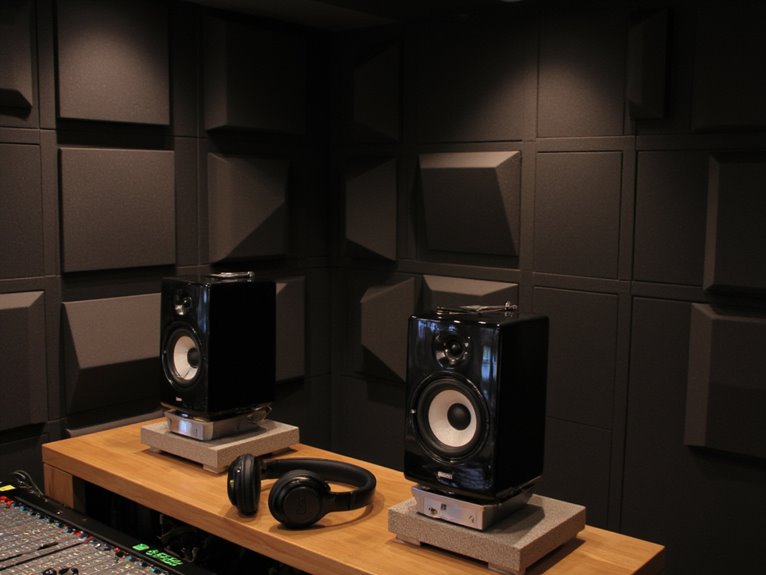
Your studio monitors can only deliver their full potential when you’ve created the right acoustic environment, which means understanding how room size directly impacts bass response and frequency accuracy.
I’ve learned that proper acoustic treatment isn’t just about throwing some foam on the walls-it requires strategic placement of absorbers, bass traps, and diffusers to control reflections while maintaining the room’s natural character.
The size of your space determines everything from monitor placement options to the type and amount of treatment you’ll need, making room optimization as essential as the monitors themselves.
Just as live sound engineers rely on studio-quality preamps in their mixers to achieve consistent audio across different venue sizes, your monitoring setup benefits from the same attention to signal quality and environmental control.
Acoustic Treatment Requirements
When selecting studio monitors over headphones for professional audio work, I’ve learned that the acoustic environment becomes just as vital as the speakers themselves.
Even the most expensive monitors can’t deliver accurate sound reproduction in an untreated room plagued by reflections, standing waves, and frequency buildups.
Proper acoustic panel placement requires strategic thinking, particularly at first reflection points on sidewalls where sound bounces back to your listening position.
Bass trap effectiveness proves essential in corners where low frequencies accumulate and create muddy monitoring conditions.
Important treatment priorities include:
- Installing 4-inch deep acoustic panels at reflection points
- Positioning bass traps in room corners for low-frequency control
- Adding ceiling treatment in rooms under 9 feet high
- Testing incrementally to avoid over-treatment that creates boxy sound
Room Size Considerations
While acoustic treatment lays the foundation for accurate monitoring, I’ve discovered that your room’s physical dimensions ultimately determine which monitors will perform best in your space, since the wrong size speakers can turn even a well-treated room into a bass-heavy nightmare or leave you straining to hear essential low-frequency details.
Small rooms typically benefit from monitors with 5-inch woofers, as larger drivers create overwhelming bass buildup and muddy responses. Your room’s length, width, and height directly influence low-frequency standing waves, making proper monitor selection vital for accurate reproduction.
I’ve learned that acoustic interactions between your speakers and room boundaries fundamentally shape what you hear, regardless of treatment quality. Similar to how microphones positioned 4-6 inches away create dramatic tonal shifts, your monitor placement distance from walls dramatically alters the frequency response and imaging characteristics you experience.
Optimal positioning requires maintaining adequate distance from walls, forming an equilateral triangle with your listening position, and considering how room acoustics affect sound propagation patterns. Just as with microphone preamps that require XLR inputs for professional signal integrity, studio monitors need properly balanced connections to maintain audio clarity throughout your monitoring chain.
When Headphones Are the Superior Choice for Audio Work
Though studio monitors remain the gold standard for most mixing applications, I’ve found that headphones actually outperform speakers in several critical scenarios where precise audio detail, consistent reference points, and isolated listening environments become paramount.
Your headphones excel when detailed scrutiny of subtle sonic elements becomes essential, revealing vocal breaths, string squeaks, and performance imperfections that monitors often miss at lower volumes.
They also provide your personal reference point across different studios, eliminating room acoustic variables that can compromise mix decisions.
Headphones prove superior for:
- Detail-oriented mixing – Acoustic and vocal-heavy tracks requiring meticulous attention
- Noisy environments – Shared studios where sound isolation prevents distractions
- Consistent monitoring – Multiple studio sessions demanding reliable frequency response
- Extended sessions – Comfortable designs supporting prolonged professional use without fatigue
Professional mixing headphones with flat frequency response across the 20Hz-20kHz range ensure accurate sound reproduction without coloration that could compromise your mix translation.
The most effective models feature noise isolation capabilities that can block significant ambient noise, creating an optimal environment for critical listening decisions.
Portable and Mobile Studio Applications
The evolution of mobile recording has transformed how I approach studio monitor selection, particularly when portability becomes as essential as sound quality in today’s increasingly flexible production environments.
When you’re working in temporary spaces, churches, or outdoor venues, portable solutions like the IK Multimedia iLoud Micro Monitor Pro deliver surprisingly detailed sound reproduction despite their compact form factor.
These monitors typically feature built-in amplifiers, USB connectivity for laptop integration, and DSP room correction capabilities that adapt to variable acoustic environments.
While they won’t match larger monitors’ low-frequency extension, they excel in mobile production scenarios where traditional monitors prove impractical.
Battery-powered options eliminate AC outlet dependence, and their rugged construction withstands frequent transport better than I initially expected.
Professional interfaces with zero-latency monitoring capabilities ensure real-time feedback during mobile recording sessions without the delay issues that can compromise performance quality.
For optimal mobile recording setups, pairing these portable monitors with affordable audio interfaces ensures professional-quality results while maintaining the flexibility needed for location-based production work.
Sound Isolation and Noise Control Considerations
When you’re choosing between studio monitors and headphones, understanding how each handles external noise isolation, sound leakage prevention, and environment-specific audio solutions becomes vital for maintaining professional mixing standards.
I’ve found that your workspace acoustics, neighbors’ tolerance levels, and time constraints will dramatically influence whether you’ll benefit more from the natural soundstage of monitors or the controlled isolation that headphones provide.
Your specific environment dictates which approach works best, since a poorly treated room can sabotage monitor accuracy while headphones might create an artificially isolated mix that doesn’t translate well to real-world listening conditions.
External Noise Isolation
While I’ve spent countless hours comparing audio equipment in various environments, I can confidently say that external noise isolation represents one of the most significant practical differences between studio monitors and headphones, particularly when you’re working in less-than-ideal acoustic conditions.
Headphones, especially closed-back models, create a physical barrier that effectively blocks external distractions, while modern noise cancellation technologies enhance this isolation further without compromising headphone comfort during extended sessions.
Consider these isolation advantages:
- Complete Environmental Control: Headphones seal around your ears, eliminating ambient noise interference
- Consistent Performance: You’ll get reliable sound quality regardless of room acoustics or external disruptions
- Focused Workflow: Enhanced concentration during critical listening tasks, even in shared spaces
- No Room Treatment Required: Immediate professional-grade isolation without acoustic panel investments
Studio monitors simply can’t compete with this level of environmental independence. Many professional headphones incorporate cardioid pickup patterns for enhanced directional sound capture, reducing unwanted noise from side and rear sources. The most advanced ANC systems can achieve up to 90% noise reduction through destructive interference, making headphones particularly effective against consistent low-frequency sounds like HVAC systems and traffic noise that commonly interfere with studio work.
Sound Leakage Prevention
Recording engineers face a constant battle against sound leakage, and I’ve witnessed countless sessions derailed by audio bleeding from headphones into sensitive microphones, creating unwanted artifacts that can ruin an otherwise perfect take. Your choice of headphone designs directly impacts recording quality, making closed-back models essential for live tracking sessions.
| Headphone Type | Sound Leakage Level | Best Use Case |
|---|---|---|
| Closed-back | Minimal leakage | Live recording |
| Open-back | High leakage | Mixing sessions |
| In-ear monitors | Very low leakage | Vocal tracking |
| Semi-open | Moderate leakage | Light monitoring |
| Studio reference | Variable | Post-production |
Professional sound leakage techniques require understanding that even closed-back headphones leak at high volumes, so monitoring levels remains vital for maintaining clean recordings without bleed-through contamination. For budget-conscious engineers seeking enhanced audio clarity, selecting headphones within the optimal 16-150 ohm range ensures proper compatibility with most recording interfaces and prevents the need for additional amplification equipment.
Environment-Specific Audio Solutions
Beyond preventing unwanted audio bleed during recording sessions, your listening environment fundamentally determines whether studio monitors or headphones will deliver accurate sound reproduction for your specific workspace.
Environmental acoustics dramatically influence which monitoring solution suits your listening preferences and practical constraints.
Consider these environment-specific scenarios when choosing your monitoring approach:
- Treated studio spaces – Monitors excel with proper acoustic treatment, bass traps, and controlled reflections
- Home studios with noise – Closed-back headphones isolate external distractions while maintaining detail resolution
- Shared workspaces – Headphones prevent disturbing others while allowing focused mixing and editing sessions
- Variable environments – Open-back headphones offer monitor-like soundstage without requiring consistent room acoustics
I’ve found that matching your monitoring choice to environmental realities, rather than fighting against acoustic limitations, produces more reliable results and reduces mixing translation issues.
Physical Comfort and Health Factors During Extended Sessions
When you’re spending hours fine-tuning mixes or evaluating audio quality, the physical demands of your monitoring setup can make or break your productivity. I’ve learned this lesson through countless late-night sessions that left me with aching ears and a stiff neck.
Your monitoring setup’s physical demands can make or break productivity during those marathon mixing sessions that stretch deep into the night.
Studio monitors require careful ergonomic setup, including proper height, angle, and seating position to prevent musculoskeletal strain. Distraction management becomes vital when sound leakage affects others nearby.
Headphones, however, create direct pressure on your ears and head, leading to faster listener fatigue and potential discomfort from clamping force. I’ve found that monitors allow longer sessions without physical contact issues, though poor room acoustics can cause listening fatigue.
On the other hand, headphones offer privacy but risk hearing damage at high volumes.
Budget Planning for Your Studio Setup
After countless hours of research and several wallet-wincing mistakes early in my career, I’ve learned that smart budget planning can make the difference between building a functional studio setup and ending up with gear that’ll have you upgrading within six months.
Here’s how I approach budget allocation for maximum impact:
- Start with budget headphone recommendations like the Audio-Technica ATH-M40x ($100) or Sony MDR-7506 for reliable tracking and initial mixing work
- Allocate $800-$1,200 for entry-level monitor pairs once you’re ready to evaluate mix translation accurately
- Prioritize workflow needs – closed-back headphones for tracking, open-back for mixing, monitors for final decisions
- Focus on cost performance balance rather than chasing premium features you won’t immediately utilize
Smart budgeting means understanding which compromises you can live with temporarily.
Creating an Effective Workflow Using Both Tools
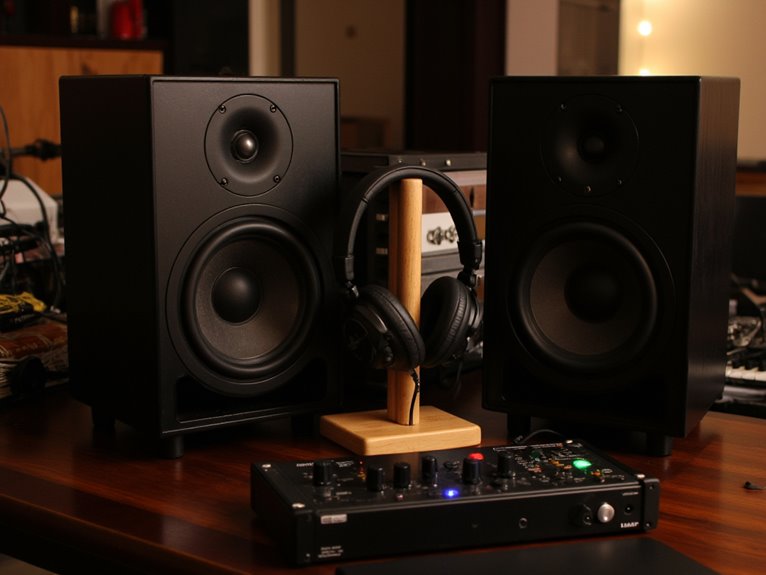
While most producers fall into the trap of treating monitors and headphones as competing tools, I’ve discovered that the real magic happens when you orchestrate them as complementary partners in a strategic workflow.
Start your sessions with monitors to establish overall balance and spatial placement, then switch to headphones for detailed EQ adjustments and compression tweaks. This workflow optimization technique prevents ear fatigue while uncovering mix inconsistencies that single-tool approaches often miss.
I recommend alternating between both tools every 20-30 minutes, employing listening strategies that leverage each tool’s strengths. Headphones excel at revealing subtle editing artifacts and fine details, while monitors provide the spatial soundstage essential for stereo imaging decisions that translate across multiple playback systems.
Professional Strategies for Mix Translation and Quality Control
Having established your dual-tool workflow, the real test comes when your carefully crafted mix hits the unforgiving reality of consumer playback systems, where translation quality separates amateur productions from professional releases.
Your success depends on implementing monitor calibration techniques that eliminate room-specific bias, while understanding how headphone frequency response differs across various models. I’ve learned that professional translation requires systematic cross-referencing between your primary monitors and multiple headphone types.
Essential quality control strategies include:
- Testing mixes on consumer-grade earbuds and smartphone speakers
- Using frequency analyzers to identify problematic ranges during headphone sessions
- Applying reference tracks through both monitors and headphones for consistency
- Implementing multiband compression adjustments based on playback device limitations
This methodical approach guarantees your mixes maintain their intended impact regardless of playback environment.
Frequently Asked Questions
Can I Use Gaming Headphones Instead of Professional Studio Headphones for Mixing?
You shouldn’t use gaming headphones for mixing because they compromise sound accuracy with boosted bass frequencies and surround effects that’ll mislead your decisions.
While I’ve seen people attempt it, gaming audio focuses on immersion rather than neutral reproduction, causing mixes that sound terrible on other systems.
Studio headphones provide the flat response you need to hear every detail clearly and make reliable mixing choices.
How Do I Calibrate Studio Monitors to Match My Room’s Acoustics?
You’ll need proper room treatment first, addressing reflective surfaces with bass traps and absorbers to minimize frequency nulls.
For calibration techniques, use an SPL meter at your listening position, targeting 74-82 dB per monitor depending on room size.
I’ve found that adjusting each monitor individually with pink noise, then using EQ to compensate for room-induced bass buildup, creates the most accurate monitoring environment for critical mixing decisions.
What Cable Types and Connections Work Best for Studio Monitor Setups?
You’ll want XLR or ¼-inch TRS balanced connections for your studio monitors since they reject noise better than RCA unbalanced cables.
I’ve found that matching your interface outputs to monitor inputs directly works best-XLR to XLR or TRS to TRS eliminates adapters.
Keep cable lengths under 25 feet to minimize signal degradation, and invest in quality shielded cables since studios have lots of electronic interference sources.
Do Open-Back or Closed-Back Headphones Perform Better for Music Production Tasks?
You’ll find open back advantages shine during mixing and mastering sessions, where their natural soundstage and accurate frequency response help you make critical decisions about spatial positioning and tonal balance.
However, closed back isolation becomes essential when you’re recording vocals or instruments, since they prevent sound leakage into microphones while providing the focused monitoring you need in noisy studio environments.
How Often Should I Replace Studio Monitors and Headphones for Optimal Performance?
Studio monitors don’t require regular replacement since their monitor lifespan extends decades with proper care.
Though I’d recommend checking drivers annually for performance degradation.
Headphone wear occurs faster, particularly with earpads needing replacement every four to five years depending on usage frequency.
You’ll want to upgrade monitors for improved sound quality rather than wear, while headphones require more frequent attention due to material deterioration from daily handling.
On a final note
You’ll find that both studio monitors and headphones serve essential, complementary roles in professional audio production, and honestly, I’ve learned that trying to rely on just one tool often leads to mixes that don’t translate well across different playback systems. While monitors excel at providing accurate spatial representation and natural listening environments, headphones offer detailed frequency analysis and practical solutions for budget-conscious setups, making the combination of both tools your strongest approach to achieving professional-quality results.

